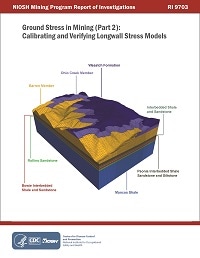Mining Publication: Ground Stress in Mining (Part 2): Calibrating and Verifying Longwall Stress Models
Original creation date: January 2020
Authors: M Larson, D Tesarik, J Johnson
NIOSHTIC2 Number: 20058392
Spokane, WA: U.S. Department of Health and Human Services, Public Health Service, Centers for Disease Control and Prevention, National Institute for Occupational Safety and Health, DHHS (NIOSH) Publication No. 2020-104 (RI 9703), 2020 Jan; :1-257
Researchers from the National Institute for Occupational Safety and Health (NIOSH) have been conducting ground control research with the goal of improving the stability of mine excavations to ensure the safety of mine workers. Part 1 of this research involves representing stress redistribution using empirical equations or numerical models that are calibrated to observations and measurements. In Part 2 of this research, reported here, numerical models are used to evaluate mine layout design to establish better procedures for predicting ground stress in mining to identify safe and unsafe working areas and escapeways. Current published guidance by the Mine Safety and Health Administration (MSHA) recommends an approach to calibrating models to observations, but it does not include recommendations for using in situ measurements to calibrate such models. A specific goal of this research is to explore and demonstrate procedures for calibrating numerical models to both observations and measurements.
In cooperation with two mining companies in the western United States, NIOSH researchers compiled large data sets of measurements and observations during mining. The purpose of these case studies was to determine ways to calibrate and verify models constructed with various modeling tools to measurements and observations, evaluate pillar strength formulas for applicability, identify deficiencies in the model calibration process, and recommend procedures for calibrating models so that longwall gate road design is improved and the margin between safe and unsafe designs is more clear. The data sets from these two mines were described in Part 1, Larson et al. [NIOSH 2020] (herein referred to as Ground Stress in Mining Part 1), of this two-part series of reports. Also in Part 1, a procedure was recommended to detect first arrival of mining-induced abutment stress ahead of the face with various instruments and with an observational survey of ground conditions. Taking such measurements is critical in the model calibration process.
In this report (Part 2), observations of floor heave and no floor heave were used to determine the general range of strength properties of the floors of the mine’s gate roads. Measurements of first arrival of mining-induced abutment stress were converted to equivalent side load transfer distances for use in calibrating models. Load transfer distance at Mine A was four times the result calculated with the empirical Peng and Chiang equation. The load transfer distance at Mine B could not be determined with the same precision, but its probable range is consistent with the load transfer distance measured at Mine A.
Calibration of rock mass stiffness or of stratigraphic moduli of elasticity was possible in these case studies using equivalent load transfer distance. However, for the boundary element code LaModel, a displacement-discontinuity program used in this analysis, the rock mass stiffness was so great that it was impossible to calibrate final gob stiffness and achieve reasonable gob loading.
The boundary element code MULSIM/NL was modified to accommodate a larger number of elements in the mesh, and a stress-versus-strain material model defined by a piecewise linear function, called the five-point material model, was added and verified. This updated version of MULSIM/NL is named MulsimNL/Large. MulsimNL/Large and FLAC3D, the latter using an unverified and uncalibrated caving model, calculated gob loading that was in a reasonable range. However, better estimates of gob loading are necessary to proceed further with full model calibration.
Detailed pillar models using FLAC3D suggested that alternatives to the Mark-Bieniawski pillar strength model should be considered, especially for pillars with a width-to-height ratio greater than eight. A Holland-Gaddy equation fit to data from FLAC3D models consisting of average pillar strength versus pillar width-to-height ratio showed better ability to describe model results than did the Mark-Bieniawski strength equation. Experience with the detailed pillar models also suggests that stratigraphy should be modeled, wherever possible.
Borehole pressure cell (BPC) trends and comparison of model-calculated load transfer distance with equivalent load transfer distance determined from measurements of first arrival of mining-induced abutment stress strongly suggest that commonly used yield models were inadequate to describe seam material behavior near the ribs at Mine A. A MulsimNL/Large elastic model with the coal modulus reduced in the outer two rings to 60% and 80% of full value, respectively, provided the best match of “measured” versus model-calculated load transfer distance derived from stress increase at each BPC site. In considering appropriate strength models that might sufficiently simulate this behavior, measurements indicate that ribs are sometimes able to take much more stress than that calculated using most common yield strengths models, suggesting that strain-hardening might be an important part of the coal pillar behavior near pillar ribs.
Observations in these two case studies (Mines A and B) suggest that geologic structure changes, not represented in the models, were important for predicting stress and instability of ground. Observations suggest that prior knowledge of structure change and individual structure properties would be necessary to adequately simulate its effect on stresses and failures with a particular mining layout.

NIOSHTIC2 Number: 20058392
Spokane, WA: U.S. Department of Health and Human Services, Public Health Service, Centers for Disease Control and Prevention, National Institute for Occupational Safety and Health, DHHS (NIOSH) Publication No. 2020-104 (RI 9703), 2020 Jan; :1-257